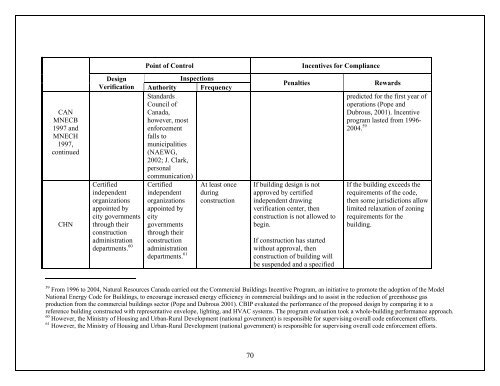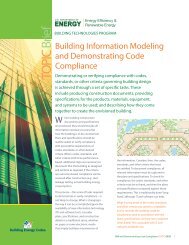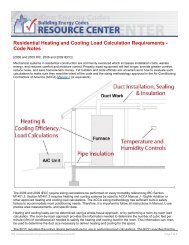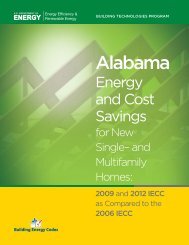Shaping the Energy Efficiency in New Buildings - Building Energy ...
Shaping the Energy Efficiency in New Buildings - Building Energy ...
Shaping the Energy Efficiency in New Buildings - Building Energy ...
You also want an ePaper? Increase the reach of your titles
YUMPU automatically turns print PDFs into web optimized ePapers that Google loves.
Po<strong>in</strong>t of ControlIncentives for ComplianceCANMNECB1997 andMNECH1997,cont<strong>in</strong>uedCHNDesignVerificationCertified<strong>in</strong>dependentorganizationsappo<strong>in</strong>ted bycity governmentsthrough <strong>the</strong>irconstructionadm<strong>in</strong>istrationdepartments. 60InspectionsAuthority FrequencyStandardsCouncil ofCanada,however, mostenforcementfalls tomunicipalities(NAEWG,2002; J. Clark,personalcommunication)Certified At least once<strong>in</strong>dependent dur<strong>in</strong>gorganizations constructionappo<strong>in</strong>ted bycitygovernmentsthrough <strong>the</strong>irconstructionadm<strong>in</strong>istrationdepartments. 61PenaltiesIf build<strong>in</strong>g design is notapproved by certified<strong>in</strong>dependent draw<strong>in</strong>gverification center, <strong>the</strong>nconstruction is not allowed tobeg<strong>in</strong>.If construction has startedwithout approval, <strong>the</strong>nconstruction of build<strong>in</strong>g willbe suspended and a specifiedRewardspredicted for <strong>the</strong> first year ofoperations (Pope andDubrous, 2001). Incentiveprogram lasted from 1996-2004. 59If <strong>the</strong> build<strong>in</strong>g exceeds <strong>the</strong>requirements of <strong>the</strong> code,<strong>the</strong>n some jurisdictions allowlimited relaxation of zon<strong>in</strong>grequirements for <strong>the</strong>build<strong>in</strong>g.59 From 1996 to 2004, Natural Resources Canada carried out <strong>the</strong> Commercial Build<strong>in</strong>gs Incentive Program, an <strong>in</strong>itiative to promote <strong>the</strong> adoption of <strong>the</strong> ModelNational <strong>Energy</strong> Code for Build<strong>in</strong>gs, to encourage <strong>in</strong>creased energy efficiency <strong>in</strong> commercial build<strong>in</strong>gs and to assist <strong>in</strong> <strong>the</strong> reduction of greenhouse gasproduction from <strong>the</strong> commercial build<strong>in</strong>gs sector (Pope and Dubrous 2001). CBIP evaluated <strong>the</strong> performance of <strong>the</strong> proposed design by compar<strong>in</strong>g it to areference build<strong>in</strong>g constructed with representative envelope, light<strong>in</strong>g, and HVAC systems. The program evaluation took a whole-build<strong>in</strong>g performance approach.60 However, <strong>the</strong> M<strong>in</strong>istry of Hous<strong>in</strong>g and Urban-Rural Development (national government) is responsible for supervis<strong>in</strong>g overall code enforcement efforts.61 However, <strong>the</strong> M<strong>in</strong>istry of Hous<strong>in</strong>g and Urban-Rural Development (national government) is responsible for supervis<strong>in</strong>g overall code enforcement efforts.70
















